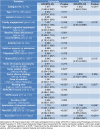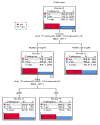Risk factors, time to onset and recurrence of delirium in a mixed medical-surgical ICU population: A secondary analysis using Cox and CHAID decision tree modeling
- PMID: 35145366
- PMCID: PMC8822304
- DOI: 10.17179/excli2021-4381
Risk factors, time to onset and recurrence of delirium in a mixed medical-surgical ICU population: A secondary analysis using Cox and CHAID decision tree modeling
Abstract
A retrospective secondary analysis of 4,200 patients was collected from two academic medical centers. Delirium was assessed using the Confusion Assessment Method for the Intensive Care Unit (CAM-ICU) in all patients. Univariate and multivariate Cox models, logistic regression analysis, and Chi-square Automatic Interaction Detector (CHAID) decision tree modeling were used to explore delirium risk factors. Increased delirium risk was associated with exposed only to artificial light (AL) hazard ratio (HR) 1.84 (95 % CI: 1.66-2.044, P<0.001), physical restraint application 1.11 (95 % CI: 1.001-1.226, P=0.049), and high nursing care requirements (>8 hours per 8-hour shift) 1.18 (95 % CI: 1.048-1.338, P=0.007). Delirium incidence was inversely associated with greater family engagement 0.092 (95 % CI: 0.014-0.596, P=0.012), low staff burnout and anticipated turnover scores 0.093 (95 % CI: 0.014-0.600, P=0.013), non-ICU length-of-stay (LOS)<15 days 0.725 (95 % CI: 0.655-0.804, P<0.001), and ICU LOS ≤15 days 0.509 (95 % CI: 0.456-0.567, P<0.001). CHAID modeling indicated that AL exposure and age <65 years were associated with a high risk of delirium incidence, whereas SOFA score ≤11, APACHE IV score >15 and natural light (NL) exposure were associated with moderate risk, and female sex was associated with low risk. More rapid time to delirium onset correlated with baseline sleep disturbance (P=0.049), high nursing care requirements (P=0.019), and prolonged ICU and non-ICU hospital LOS (P<0.001). Delirium recurrence correlated with age >65 years (HR 2.198; 95 % CI: 1.101-4.388, P=0.026) and high nursing care requirements (HR 1.978, 95 % CI: 1.096-3.569), with CHAID modeling identifying AL exposure (P<0.001) and age >65 years (P=0.032) as predictive variables. Development of ICU delirium correlated with application of physical restraints, high nursing care requirements, prolonged ICU and non-ICU LOS, exposure exclusively to AL (rather than natural), less family engagement, and greater staff burnout and anticipated turnover scores. ICU delirium occurred more rapidly in patients with baseline sleep disturbance, and recurrence correlated with the presence of delirium on ICU admission, exclusive AL exposure, and high nursing care requirements.
Keywords: Intensive Care Units; Iran; critical care; delirium; risk factors.
Copyright © 2022 Rahimibashar et al.
Figures







Similar articles
-
[Risk factors for delirium in intensive care unit and its duration].Zhonghua Wei Zhong Bing Ji Jiu Yi Xue. 2020 Jan;32(1):62-66. doi: 10.3760/cma.j.cn121430-20190909-00011. Zhonghua Wei Zhong Bing Ji Jiu Yi Xue. 2020. PMID: 32148233 Chinese.
-
Intensive care unit delirium is an independent predictor of longer hospital stay: a prospective analysis of 261 non-ventilated patients.Crit Care. 2005 Aug;9(4):R375-81. doi: 10.1186/cc3729. Epub 2005 Jun 1. Crit Care. 2005. PMID: 16137350 Free PMC article.
-
Incidence, characteristics and risk factors of delirium in the intensive care unit: An observational study.J Clin Nurs. 2023 Jan;32(1-2):96-105. doi: 10.1111/jocn.16197. Epub 2022 Jan 3. J Clin Nurs. 2023. PMID: 35639976
-
Delirium as a predictor of mortality in mechanically ventilated patients in the intensive care unit.JAMA. 2004 Apr 14;291(14):1753-62. doi: 10.1001/jama.291.14.1753. JAMA. 2004. PMID: 15082703
-
Factors Related to Delirium of Intensive Care Unit Patients in Korea: A Systematic Review.Iran J Public Health. 2021 Aug;50(8):1526-1535. doi: 10.18502/ijph.v50i8.6798. Iran J Public Health. 2021. PMID: 34917523 Free PMC article. Review.
Cited by
-
Classifiers of anterior cruciate ligament status in female and male adolescents using return-to-activity criteria.Knee Surg Sports Traumatol Arthrosc. 2025 May;33(5):1633-1644. doi: 10.1002/ksa.12462. Epub 2024 Sep 30. Knee Surg Sports Traumatol Arthrosc. 2025. PMID: 39344772 Free PMC article.
-
Knowledge, attitude, and practice toward delirium and subtype assessment among Chinese clinical nurses and determinant factors: A multicentre cross-section study.Front Psychiatry. 2023 Feb 1;13:1017283. doi: 10.3389/fpsyt.2022.1017283. eCollection 2022. Front Psychiatry. 2023. PMID: 36819944 Free PMC article.
-
Reducing the effect of immortal time bias affects the analysis of prevention of delirium by suvorexant in critically ill patients: A retrospective cohort study.PLoS One. 2022 Dec 1;17(12):e0277916. doi: 10.1371/journal.pone.0277916. eCollection 2022. PLoS One. 2022. PMID: 36454811 Free PMC article.
-
Predictive Model of Functional Exercise Compliance of Patients with Breast Cancer Based on Decision Tree.Int J Womens Health. 2023 Mar 21;15:397-410. doi: 10.2147/IJWH.S386405. eCollection 2023. Int J Womens Health. 2023. PMID: 36974132 Free PMC article.
-
What's New in Critical Illness and Injury Science? Delirium, COVID-19, and critical illness.Int J Crit Illn Inj Sci. 2022 Apr-Jun;12(2):59-60. doi: 10.4103/ijciis.ijciis_44_22. Epub 2022 Jun 24. Int J Crit Illn Inj Sci. 2022. PMID: 35845126 Free PMC article. No abstract available.
References
-
- Adams A, Hollingsworth A, Osman A. The implementation of a cultural change toolkit to reduce nursing burnout and mitigate nurse turnover in the emergency department. J Emerg Nurs. 2019;45:452–456. - PubMed
-
- American Psychiatric Association. Diagnostic and statistical manual. 5th ed. Washington, DC: APA Press; 2013.
-
- Arenson BG, Macdonald LA, Grocott HP, Hiebert BM, Arora RC. Effect of intensive care unit environment on in-hospital delirium after cardiac surgery. J Thorac Cardiovasc Surg. 2013;146:172–178. - PubMed
-
- Barlow KM, Zangaro GA. Meta-analysis of the reliability and validity of the Anticipated Turnover Scale across studies of registered nurses in the United States. J Nurs Manag. 2010;18:862–873. - PubMed
LinkOut - more resources
Full Text Sources
